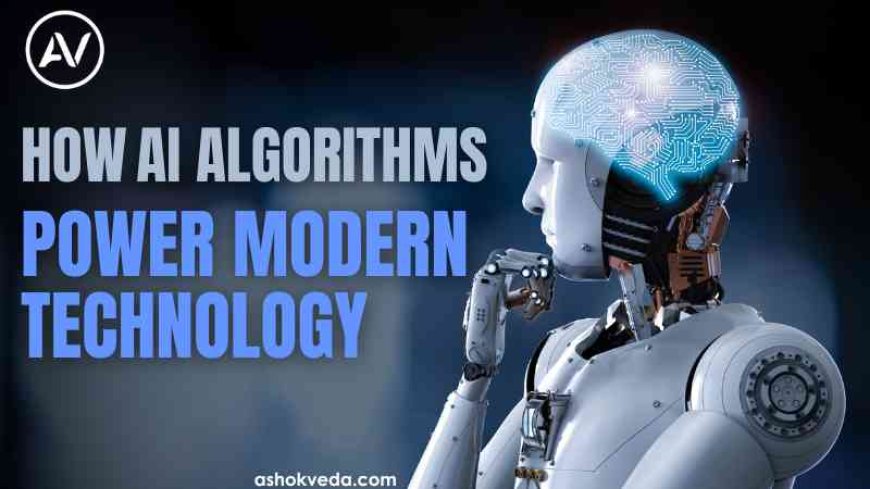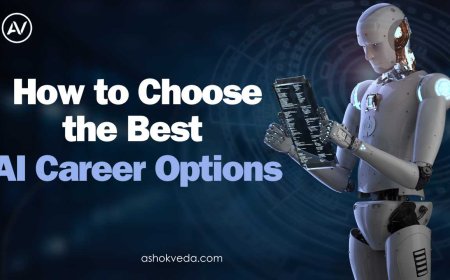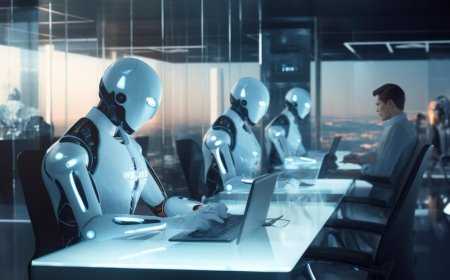How AI Algorithms Power Modern Technology?
Learn how AI algorithms are driving advancements in modern technology, from automation to data processing, and improving efficiency.

Have you ever wondered how your smartphone knows what you’re typing or how your favorite streaming service recommends shows you might like? All of this is possible because of something amazing: AI algorithms. You've come to an excellent spot if you're interested in learning more about how AI algorithms power modern technology. We'll look into the field of Artificial Intelligence algorithms to see how they power modern technology in unexpected ways.
What Are AI Algorithms?
AI algorithms are collections of instructions or directions that are provided to a computer that allows self-learning and data-driven decision-making. Many modern technologies, such as personalized suggestions and virtual assistants, depend on these algorithms. AI algorithms assist Robots in performing activities that usually need human intelligence by absorbing huge amounts of data.
How AI Algorithms Power Modern Technology
The term "How AI Algorithms Power Modern Technology" refers to how these algorithms increase the intelligence, usability, and productivity of technology. A closer look at how AI algorithms are influencing the world around us is provided below
-
Personalized Recommendations: Think about how Netflix or Spotify seems to know exactly what you want to watch or listen to. That’s the magic of AI algorithms at work. By analyzing your past behavior and preferences, these algorithms predict what you might enjoy next, creating a tailored experience just for you.
-
Voice Assistants: Ever asked Siri or Alexa to set a reminder or play a song? AI algorithms enable these voice assistants to understand and process your voice commands. They convert spoken language into text, interpret it, and execute tasks based on your request, making everyday tasks easier.
-
Smart Home Devices: From adjusting the thermostat to turning on the lights, smart home devices rely on AI algorithms to learn your habits and preferences. They use this information to automate tasks and create a more comfortable living environment.
-
Autonomous Vehicles: Self-driving cars are one of the most exciting applications of AI algorithms. These algorithms process data from sensors and cameras to navigate roads, recognize obstacles, and make real-time decisions, making autonomous driving a reality.
-
Healthcare Innovations: In healthcare, AI algorithms assist in diagnosing diseases, analyzing medical images, and even predicting patient outcomes. By examining large datasets, these algorithms can identify patterns that may not be immediately visible to human doctors.
-
Financial Services: Banks and financial institutions use AI algorithms for fraud detection, credit scoring, and trading. These algorithms analyze transaction patterns and market data to identify suspicious activities and make informed decisions.
-
E-commerce: Online shopping platforms use AI algorithms to enhance the shopping experience. They recommend products based on your browsing history, predict trends, and even optimize pricing strategies to boost sales.
The Science Behind AI Algorithms
It's useful to understand the theory behind AI algorithms to understand How AI Algorithms Power Modern Technology with a simplified explanation:
-
Data Collection: AI algorithms start with data. This data can be anything from user behavior to sensor readings. The more data an algorithm has, the better it can learn and make accurate predictions. Data mining is crucial in this phase, as it helps gather and process large volumes of data.
-
Training: Once the data is collected, it’s used to train the AI algorithms. During this process, the algorithm learns to recognize patterns and make decisions based on the data it’s been given. Techniques such as Machine Learning, neural networks, and Deep Learning are often employed during this stage.
-
Model Building: After training, the algorithm creates a model that can be used to make predictions or perform tasks. This model is tested and refined to improve accuracy. Methods like supervised learning and unsupervised learning are commonly used in this phase.
-
Deployment: Once the model is ready, it’s deployed in real-world applications. Whether it’s a recommendation engine or a voice assistant, AI algorithms are integrated into technology to provide enhanced functionality.
-
Continuous Learning: One of the remarkable aspects of AI algorithms is their ability to learn and improve over time. As they process more data, they become more accurate and efficient, continually enhancing their performance. This concept is central to predictive analytics and reinforcement learning.
AI Algorithm Examples in the World of Reality
Let's analyze a few real-life examples to gain a better understanding of How AI Algorithms Power Modern Technology:
-
Google Search: When you search for something on Google, AI algorithms analyze your query and deliver the most relevant results. They consider factors like your search history and the context of your query to provide accurate answers. This process involves Natural Language Processing (NLP) to understand and interpret human language.
-
Amazon Recommendations: When you browse products on Amazon, AI algorithms analyze your browsing history and purchase patterns to suggest items you might like. These personalized recommendations are powered by complex AI algorithms that understand your preferences.
-
Social Media Feeds: Platforms like Facebook and Instagram use AI algorithms to curate your newsfeed. These algorithms analyze your interactions, such as likes and comments, to show you content that aligns with your interests. AI applications in social media often involve cognitive computing to make the experience more engaging.
-
Spam Filters: Email services use AI algorithms to filter out spam and phishing attempts. By analyzing patterns in emails and known characteristics of spam, these algorithms help keep your inbox clean. Automated systems are crucial in this process to ensure efficiency and accuracy.
-
Customer Service Chatbots: Many companies use chatbots powered by AI algorithms to handle customer inquiries. These chatbots can understand and respond to common questions, providing quick and efficient support. AI training helps improve their responses over time.
Challenges and Future of AI Algorithms
While AI algorithms are very powerful, they have limitations. Important problems include protecting data privacy, removing bias, and upholding transparency. To fully realize the potential of AI technology, these issues must be resolved as it continues to advance.
The future of AI algorithms is bright, with advancements expected in areas like cognitive computing, intelligent systems, and AI research. These developments will further enhance the capabilities of AI algorithms, leading to even more innovative applications in technology.
Understanding How AI Algorithms Power Modern Technology reveals just how integral these algorithms are to our daily lives. From personalized recommendations to autonomous vehicles, AI algorithms are at the core of many technological advancements. By processing vast amounts of data and learning from it, these algorithms make technology smarter and more intuitive, shaping the way we interact with the field.
The possibilities are unlimited as we investigate and improve AI algorithms. Accepting these technologies and realizing their effects will allow us to confidently cross the innovative future. So keep in mind the amazing role AI algorithms play in making it all possible the next time you use a smart device or see an online recommendation!





































